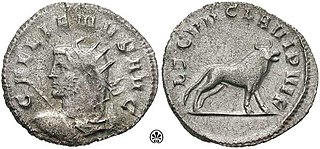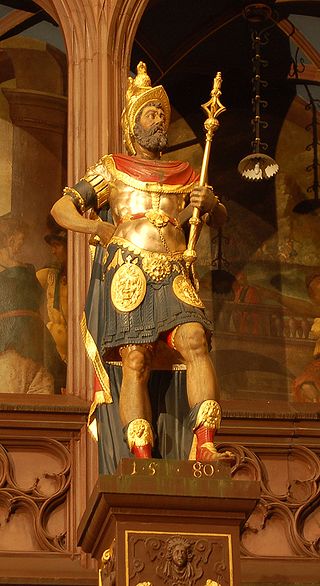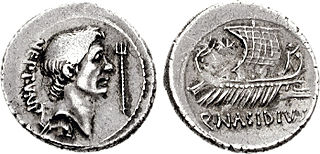
Commentarii de Bello Gallico, also Bellum Gallicum, is Julius Caesar's firsthand account of the Gallic Wars, written as a third-person narrative. In it, Caesar describes the battles and intrigues that took place in the nine years he spent fighting the Celtic and Germanic peoples in Gaul that opposed Roman conquest.
Aulus Hirtius was consul of the Roman Republic in 43 BC and a writer on military subjects. He was killed during his consulship in battle against Mark Antony at the Battle of Mutina.
Lucius Cornelius Balbus was born in Gades early in the first century BC. Lucius Cornelius Balbus was a wealthy Roman politician and businessman of Punic origin and a native of Gades in Hispania, who played a significant role in the emergence of the Principate at Rome. He was a prominent supporter of Julius Caesar and a close advisor to the emperor Augustus.
Orgetorix was a wealthy aristocrat among the Helvetii, a Celtic-speaking people residing in what is now Switzerland during the consulship of Julius Caesar of the Roman Republic.
Gaius Oppius was an intimate friend of Julius Caesar. He managed the dictator's private affairs during his absence from Rome, and, together with Lucius Cornelius Balbus, exercised considerable influence in the city.
Bellum civile, or civil war in Latin, may refer to:

Commentarii de Bello Civili(Commentaries on the Civil War), or Bellum Civile, is an account written by Julius Caesar of his war against Gnaeus Pompeius and the Roman Senate. It consists of three books covering the events of 49–48 BC, from shortly before Caesar's invasion of Italy to Pompey's defeat at the Battle of Pharsalus and flight to Egypt. It was preceded by the much longer account of Caesar's campaigns in Gaul and was followed by similar works covering the ensuing wars against the remnants of Pompey's armies in Egypt, North Africa, and Spain. Caesar's authorship of the Commentarii de Bello Civili is not disputed, while the three later works are believed to have been written by contemporaries of Caesar.

De Bello Hispaniensi is a Latin work continuing Julius Caesar's commentaries, De Bello Gallico and De Bello Civili, and its sequels by two different unknown authors De Bello Alexandrino and De Bello Africo. It details Caesar's campaigns on the Iberian Peninsula, ending with the Battle of Munda.
De Bello Africo is a Latin work continuing Julius Caesar's accounts of his campaigns, De Bello Gallico and De Bello Civili, and its sequel by an unknown author De Bello Alexandrino. It details Caesar's campaigns against his Republican enemies in the province of Africa.

Titus Terrasidius was a Roman Knight of the Equestrian order and an officer of the cavalry in Julius Caesar's Legio VII Claudia. He and other officers of the legion were sent out to negotiate provisions for the winter of 56–55 BC; they were captured by Breton tribes who were then subjugated as Caesar describes in his Commentarii de Bello Gallico:
The occasion of that war was this: Publius Crassus, a young man, had taken up his winter-quarters with the seventh legion among the Andes, who border upon the Ocean. He, as there was a scarcity of corn in those parts, sent out some officers of cavalry [who would be equites], and several military tribunes [who would be of senatorial rank] among the neighbouring states, for the purpose of procuring corn and provision; in which number Titus Terrasidius was sent among the Esubii; Marcus Trebius Gallus among the Curiosolitae; Quintus Velanius, [and] Titus Silius, amongst the Veneti.
During the Second Punic War with Carthage, Rome's earliest known annalists Quintus Fabius Pictor and Lucius Cincius Alimentus recorded history in Greek, and relied on Greek historians such as Timaeus. Roman histories were not written in Classical Latin until the 2nd century BCE with the Origines by Cato the Elder. Contemporary Greek historians such as Polybius wrote about the rise of Rome during its conquest of Greece and ascension as the primary power of the Mediterranean in the 2nd century BCE. Moving away from the annalist tradition, Roman historians of the 1st century BCE such as Sallust, Livy, and even Julius Caesar wrote their works in a much fuller narrative form. While Caesar's De Bello Gallico focused specifically on his wars in Gaul, Roman works that served as a broad universal history often placed heavy emphasis on the origin myth of the founding of Rome as a starting point. These works formed the basis of the Roman historiographic models utilized by later Imperial authors of the Principate era, such as Tacitus and Suetonius.
The gens Atia, sometimes written Attia, was a minor plebeian family at Ancient Rome. The first of this gens to achieve prominence was Lucius Atius, a military tribune in 178 BC. Several of the Atii served in the Civil War between Caesar and Pompeius. The gens Attia of imperial times may be descended from this family, although its members lived nearly a century after the more notable Atii, and are not known to have been related.
The gens Sextia was a plebeian family at ancient Rome, from the time of the early Republic and continuing into imperial times. The most famous member of the gens was Lucius Sextius Lateranus, who as tribune of the plebs from 376 to 367 BC, prevented the election of the annual magistrates, until the passage of the lex Licinia Sextia, otherwise known as the "Licinian Rogations," in the latter year. This law, brought forward by Sextius and his colleague, Gaius Licinius Calvus, opened the consulship to the plebeians, and in the following year Sextius was elected the first plebeian consul. Despite the antiquity of the family, only one other member obtained the consulship during the time of the Republic. Their name occurs more often in the consular fasti under the Empire.

The gens Considia was a plebeian family at ancient Rome. The Considii came to prominence in the last century of the Republic, and under the early Empire, but none of them rose any higher than the praetorship.

Aggar was a town and bishopric in the Roman province of Byzacena. One of two cities in the area, it left vast ruins that are now called (Henchir) Sidi Amara. These edifices are situated in the plain of Siliana, around 60 kilometres east of Maktar.

The gens Munatia was a plebeian family at Rome. Members of this gens are first mentioned during the second century BC, but they did not obtain any of the higher offices of the Roman state until imperial times.

The gens Nasidia was an obscure plebeian family at Rome. The gens is best known from Quintus Nasidius, one of the admirals of Gnaeus Pompeius Magnus during the Civil War. Although none of the Nasidii are known to have held any of the higher offices of the Roman state, a number are known from inscriptions. A coin of this gens depicts the head of Pompeius and a trident on the obverse, and on the reverse a ship, with the inscription Q. Nasidius.
The gens Pedia was a plebeian family at ancient Rome. Members of this gens are first mentioned in history during the final century of the Republic, and for the next two centuries they were distinguished in statesmanship, rhetoric, art, and law. The first of the Pedii to obtain the consulship was Quintus Pedius, the nephew of Caesar, in 43 BC.
The gens Petreia was a minor plebeian family at ancient Rome. Members of this gens are first mentioned toward the end of the second century BC, and several were distinguished as soldiers, but none of them ever attained the consulship.

Carl Ludwig Nipperdey, also Karl Ludwig Nipperdey was a German classical philologist.









